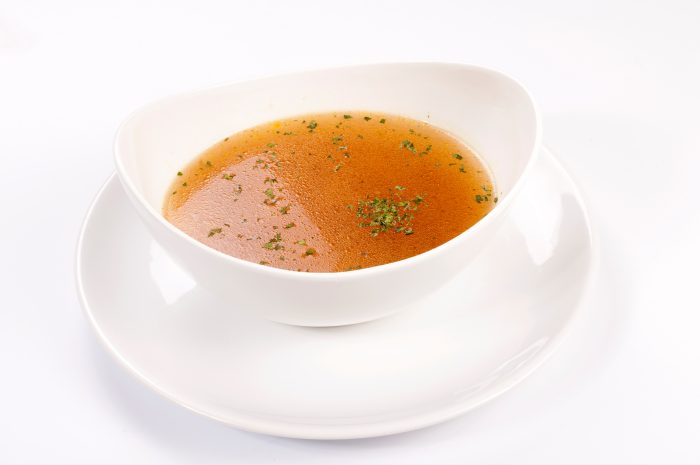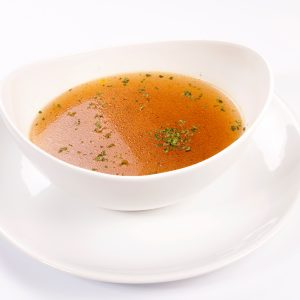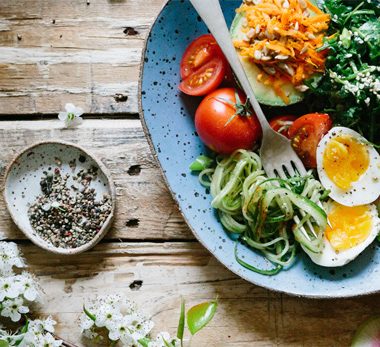Bone Broth: A Nourishing Food


I think our fast-paced lives have kept most of us away from making “traditional” foods because it’s far more convenient to grab a can or box of pre-made versions at the store – like fermented vegetables, cultured dairy, organ meats, and bone broth.
But the good news is that while bone broth has a long cooking time, the prep and effort is minimal and the benefits are worth it! Here is a brief overview and how to get started.
A homemade bone broth will deliver your body calcium, phosphorous, magnesium, sodium, potassium, sulfate, and fluoride—in a form that your body understands. Bones, marrow, skin, tendons, ligaments, and the cartilage that sometimes accompanies a bone are all made of a protein molecule called collagen. Collagen contains two very special amino acids: proline and glycine that may heal any damaged cell walls (that’s a good thing!).
Collagen has been found to help heal the lining of the gastrointestinal tract, which includes the stomach and the intestines. In addition to collagen, cartilage also contains gelatin, which has been shown to benefit gastric ulcers and other inflammations of the digestive system.
How to make it
Go for variety when collecting bones. The marrow found in bones is either yellow marrow or red marrow. Yellow marrow is found in the central portion of long bones. It is where fats are stored. Red marrow, on the other hand, is found in flat bones. These are: hip bone, sternum, skull, ribs, vertebrae, scapula, and the ends of long bones.
Quality matters. Make sure that all bones are sourced from animals that are organic and grass-fed or pastured and free-range. Remember, everything that the animal ate, how it lived, and where it lived all factor into the health benefits of your broth. You would not want to consume broth made from the bones of an animal that was factory-farmed, treated with steroids and antibiotics, confined, and fed GMO corn or soy. Animals that are pastured, eating grass and exposed to natural sunlight are healthy.
You can purchase bones from your local farmer or at a natural food market, or you can collect bones from meals and store them in your freezer until you have enough to build a good stock. When I roast an entire organic chicken or make chicken wings I simply freeze the bones after our meal for broth to be made at another time. If you are using large bones, ask the butcher to cut them into smaller pieces. This reduces cooking time and allows more material to become a part of the broth. Another option is to purchase organic, grass-fed bones online at U.S. Wellness Meats. This is where I order my chicken feet, necks and backs.

- Bones (Chicken or Beef)
- 2 tbs. Apple Cider Vinegar
- Filtered Water
- Onions (optional)
- Carrots (optional)
- Place chicken or beef bones into a large stock pot and cover with water. Fill the pot with filtered water and leave room for water to boil.
- Add two tablespoon of apple cider vinegar or wine to water prior to cooking. The acidity helps pull out important nutrients from the bones.
- Heat slowly. Bring to a boil and remove any scum as it rises, then reduce heat to simmer for a minimum of six hours. Chicken bones can cook for six to forty-eight hours. I usually cook mine for thirty-six hours. Beef bones can cook for twelve to seventy-two hours. A long and slow cook time is necessary in order to fully extract the nutrients in and around bone. If you don’t have a gas stove, use a crockpot. You will not be able to control temperature with an electric stovetop.
- After cooking, allow the broth to cool and transfer to several glass mason jars. Leave about an inch of room at the top for expansion if you plan to store in the freezer (I learned that the hard way!). A layer of fat will harden on top once it’s refrigerated. This layer protects the broth beneath. Discard this layer only when you are about to eat the broth. Consume broth within one to two weeks or freeze for later use.
- The amount of bones I use varies. If I have the leftover bones from a full roasted chicken I will simply add 2-4 breast bones to the batch. If you don't have a large quantity of bones, you can add some vegetables (onions,carrots, leeks, celery) and make a vegetable/chicken stock. You will discard the veggies after the stock is cooked.
- We use our broth to make risotto, homemade soups or to cook rice (in place of using plain water). If anyone is sick we make a healing elixir with warm broth, ginger, lemon and parsley.







